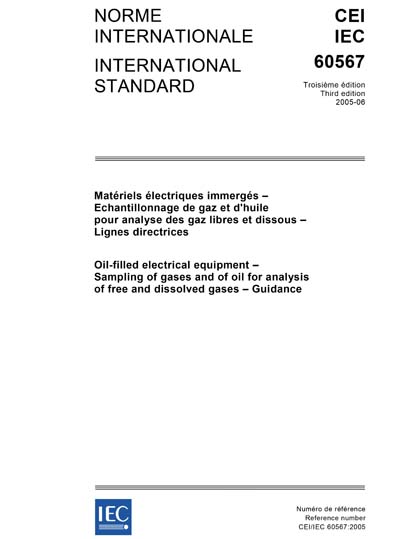Historical
IEC 60567 Ed. 3.0 b:2005
Oil-filled electrical equipment - Sampling of gases and of oil for analysis of free and dissolved gases - Guidance
Deals with the techniques for sampling free gases from gas-collecting relays and for sampling oil from oil-filled equipment such as power and instrument transformers, reactors, bushings, oil-filled cables and oil-filled tank-type capacitors. Three methods of sampling free gases and three methods of sampling oil are described; the choice between the methods often depends on the apparatus available and on the quantity of oil needed for analysis. Before analysing the gases dissolved in oil, they must first be extracted from the oil. Three basic methods are described, one using extraction by vacuum (Toepler and partial degassing), another by displacement of the dissolved gases by bubbling the carrier gas through the oil sample (stripping), and the last one by partition of gases between the oil sample and a small volume of the carrier gas (head space). The gases are analysed quantitatively after extraction by gas chromatography; a method of analysis is described. Free gases from gas-collecting relays are analysed without preliminary treatment. The preferred method for assuring the performance of the gas extraction and analysis equipment, considered together as a single system, is to degas samples of oil prepared in the laboratory and containing known concentrations of gases (""gas-in-oil standards"") and quantitatively analyse the gases extracted. Two methods of preparing gas-in-oil standards are described. For daily calibration checks of the chromatograph, it is convenient to use a standard gas mixture containing a suitable known amount of each of the gas components to be in a similar ratio to the commons ratios of the gases extracted from transformer oils. The techniques described take account, on the one hand, of the problems peculiar to analyses associated with acceptance testing in the factory, where gas contents of oil are generally very low and, on the other hand, of the problems imposed by monitoring equipment in the field, where transport of samples may be by un-pressurized air freight and where considerable differences in ambient temperature may exist between the plant and the examining laboratory. The main changes with respect to the previous edition are listed below. Since the publication of the second edition of this standard, a number of new gas extraction methods have been developed and are commercially available, such as mercury-free versions of the standard Toepler and partial degassing methods, which are referenced to in Annex C of the present edition. The head space method, based on a new concept for the extraction of gases from oil is introduced as a full method in this third edition, and reference is made to a simplified version of it also in Annex C (shake test method). More sensitive chromatographic techniques have also been developed since the last edition, and are presented in this third edition.
Content Provider
International Electrotechnical Commission [iec]






